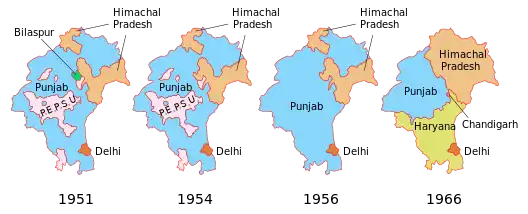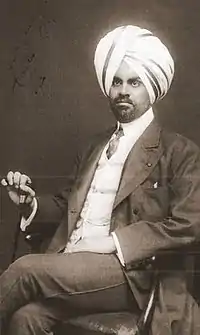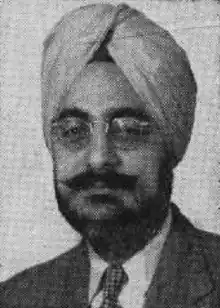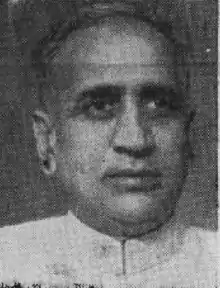| Patiala and East Punjab States Union | |||||||||||||||
|---|---|---|---|---|---|---|---|---|---|---|---|---|---|---|---|
| State of India | |||||||||||||||
| 1948–1956 | |||||||||||||||
.svg.png.webp) 1951 map of India. The Patiala and East Punjab States Union is shown forming enclaves in East Punjab. | |||||||||||||||
| Capital | Patiala | ||||||||||||||
| Area | |||||||||||||||
• 1951 | 26,208 km2 (10,119 sq mi) | ||||||||||||||
| Population | |||||||||||||||
• 1951 | 3493685 | ||||||||||||||
| • Type | Democracy | ||||||||||||||
| Legislature | Patiala and East Punjab States Union Legislative Assembly | ||||||||||||||
| History | |||||||||||||||
• State Established | 15 July 1948 | ||||||||||||||
• State Disestablished | 1 November 1956 | ||||||||||||||
| |||||||||||||||
| Today part of | India | ||||||||||||||
The Patiala and East Punjab States Union (PEPSU) was a state of India, uniting eight princely states between 1948 and 1956. The capital and principal city was Patiala. The state covered an area of 26,208 km². Shimla, Kasauli, Kandaghat and Chail also became part of the PEPSU.
History
Princely states union
It was created by combining eight princely states, which maintained their native rulers :
- Six Salute states
- Patiala, title Maharaja, Hereditary salute of 17-guns (19-guns local)
- Jind, title Maharaja, Hereditary salute of 13-guns (15-guns personal and local)
- Kapurthala, title Maharaja, Hereditary salute of 13-guns (15-guns personal and local)
- Nabha, title Maharaja, Hereditary salute of 13-guns (15-guns local):
- Faridkot, title Raja, Hereditary salutes of 11-guns
- Malerkotla, title Nawab, Hereditary salute of 11-guns
- and two Non-salute states
The state was inaugurated on 15 July 1948 and formally became a state of India in 1950.
Successor states

On 1 November 1956, PEPSU was merged mostly into Punjab State following the States Reorganisation Act.[1]
A part of the former state of PEPSU, including the present day Jind district and the Narnaul tehsil in north Haryana as well as the Loharu tehsil, Charkhi Dadri district and Mahendragarh district in southwest Haryana, presently lie within the state of Haryana, which was separated from Punjab on 1 November 1966. Some other areas that belonged to PEPSU, notably Solan and Nalagarh, now lie in the state of Himachal Pradesh.
Rajpramukh and Uparajpramukh
| S. no. | Rajpramukh | Portrait | Tenure | Uparajpramukh | Portrait | Appointed by | ||
|---|---|---|---|---|---|---|---|---|
| 1 | Yadavindra Singh | .jpg.webp) |
15 July 1948 | 1 November 1956 | 8 years, 109 days | Jagatjit Singh |  |
C. Rajagopalachari |
Chief Ministers
| No | Portrait | Name
(Birth–Death) |
Party (Alliance/ Partner) |
Term of office | Time in office | Assembly (Election) |
Appointed by | ||
|---|---|---|---|---|---|---|---|---|---|
| Took office | Left office | ||||||||
| Premier (1948-1952) | |||||||||
| - |  |
Gian Singh Rarewala (1901-1979) ( – ) |
IND | 15 July 1948 | 13 January 1949 | 182 days | Not Yet Created | Yadavindra Singh | |
| 1 |  |
Gian Singh Rarewala (1901-1979) ( – ) |
13 January 1949 | 23 May 1951 | 2 years, 130 days | ||||
| 2 | Raghbir Singh (1895-1955) ( – ) |
Indian National Congress | 23 May 1951 | 21 April 1952 | 1 year, 333 days | ||||
| Chief Minister (1952-1956) | |||||||||
| 1 | Raghbir Singh (1895-1955) (Patiala Sadar) |
Indian National Congress | 21 April 1952 | 22 April 1952 | 1 day | 1st (1952) |
Yadavindra Singh | ||
| 2 |  |
Gian Singh Rarewala (1901-1979) (Amloh) |
IND (UDF) |
22 April 1952 | 5 March 1953 | 317 days | |||
| (i) |  |
Vacant[lower-alpha 1] (President's rule) |
- | 5 March 1953 | 8 March 1954 | 1 year, 3 days | - | Rajendra Prasad | |
| (1) | Raghbir Singh (1895-1955) (Patiala Sadar) |
Indian National Congress | 8 March 1954 | 12 January 1955[d] | 310 days | 2nd (1954) |
Yadavindra Singh | ||
| 3 |  |
Brish Bhan (1908-1988) (Kalayat) |
12 January 1955 | 1 November 1956[pd] | 1 year, 294 days | ||||
Deputy Chief Minister
| Sr. No. | Name | Portrait | Term of office | Political Party | Chief Minister | ||
|---|---|---|---|---|---|---|---|
| 1 | Brish Bhan |  |
23 May 1951 | 21 April 1952 | Indian National Congress | Raghbir Singh | |
| 8 March 1954 | 12 January 1955 | ||||||
Institutions

Heads of state and government
When the state was formed, the then-Maharaja of Patiala, Yadavindra Singh, was appointed its Rajpramukh (equivalent to Governor). He remained in office during the entire length of the state's short existence. The then Maharaja of Kapurthala, Jagatjit Singh, served as Uparajpramukh (lieutenant-governor).
Gian Singh Rarewala was sworn in on 13 January 1949 as the first Chief Minister of PEPSU. Col. Raghbir Singh became the next Chief Minister on 23 May 1951, and Brish Bhan the Deputy Chief Minister.
The state elected a 60-member state legislative assembly on 6 January 1952. The Congress Party won 26 seats and the Akali Dal won 19 seats.
On 22 April 1952, Gian Singh Rarewala again became Chief Minister, this time an elected one. He led a coalition government, called the "United Front", formed by the Akali Dal and various independents. On 5 March 1953 his government was dismissed and President's rule was imposed on the state.[3] In the mid-term poll that followed, the Congress party secured a majority and Raghbir Singh became Chief Minister on 8 March 1954. Upon his death, Brish Bhan became the Chief Minister on 12 January 1955 and remained in office as last incumbent.
Subdivisions
Initially, in 1948, the state was divided into the following eight districts:
In 1953, the number of districts was reduced from eight to five. Barnala district became part of Sangrur district and Kohistan and Fatehgarh districts became part of Patiala district.[4]
There were four Lok Sabha constituencies in this state. Three of them were single-seat constituency: Mohindergarh, Sangrur and Patiala. The Kapurthala-Bhatinda Lok Sabha constituency was a double-seat constituency.
Demography
The state had a population of 3,493,685 (1951 census), of which 19% was urban. The population density was 133/km².[5]
Notes
- ↑ President's rule may be imposed when the "government in a state is not able to function as per the Constitution", which often happens because no party or coalition has a majority in the assembly. When President's rule is in force in a state, its council of ministers stands dissolved. The office of chief minister thus lies vacant, and the administration is taken over by the governor, who functions on behalf of the central government. At times, the legislative assembly also stands dissolved.[2]
References
- ↑ "States Reorganisation Act, 1956". India Code Updated Acts. Ministry of Law and Justice, Government of India. 31 August 1956. pp. section 9. Retrieved 16 May 2013.
- ↑ Amberish K. Diwanji. "A dummy's guide to President's rule". Rediff.com. 15 March 2005.
- ↑ Singh, Roopinder (16 December 2001). "Rarewala: A Punjabi-loving gentleman-aristocrat". The Tribune.
- ↑ "History of Jind district". Jind district website. Archived from the original on 16 July 2011. Retrieved 19 March 2011.
- ↑ "Patiala and East Punjab States Union". The Sikh Encyclopedia. Archived from the original on 21 August 2017. Retrieved 11 November 2016.
Further reading
- Singh, Gursharan (1991). History of PEPSU, India: Patiala and East Punjab States Union, 1948-1956, Delhi: Konark Publishers, ISBN 81-220-0244-7.
31°27′N 77°36′E / 31.45°N 77.60°E